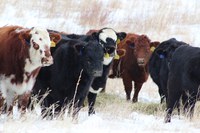NDSU Research Increases Beef Cattle Knowledge
(Click the image below to view a high-resolution image that can be downloaded)
The effects of cold temperatures on feed intake, the type of breeding system used in beef cattle and adding pea starch to feedlot finishing diets, and the quality of the hay harvested from roadside ditches were a few of the beef cattle topics North Dakota State University animal scientists and Extension Service specialists studied in the past year.
In the cold temperatures study, scientists from the Animal Sciences Department found that pregnant cows ate more in November and December because temperatures were getting colder. However, the cows’ feed intake didn’t increase much in January.
“A hypothesis for this is that they had become acclimated to the colder temperatures and maintained nutrition,” scientist Marc Bauer says.
But feed intake again increased in February, even though temperatures were warming. The scientists believe that increase was due to the cows being in their third trimester of pregnancy, when they would need more nutrients and energy.
The breeding system study, also by Animal Sciences Department scientists, showed that cows bred by artificial insemination calved nearly eight days earlier than cows only exposed to bulls (natural-service breeding). The scientists also found that calves born to cows bred by artificial insemination weighed more at weaning than calves born to cows just exposed to natural-service breeding.
These findings indicate that using estrous synchronization and artificial insemination could have potential benefits for producers, according to scientist Carl Dahlen.
Using artificial insemination didn’t affect the proportion of cows that became pregnant, however.
In the pea starch research, scientists at the Carrington Research Extension Center found that a feed pellet made with 30 percent pea starch and 70 percent dry distillers grains with solubles (DDGS) and fed at 15 or 30 percent of the diet’s dry matter can be an effective ingredient in feedlot finishing diets. They also found that this pellet can replace DDGS and some corn in those diets.
The hay research was a collaborative effort of scientists and Extension specialists from the Animal Sciences Department, School of Natural Resources Sciences and Central Grasslands Research Extension Center near Streeter, and Extension agents who worked with producers to collect 182 samples of hay harvested from ditches throughout the state.
Producers commonly harvest hay from forages growing in roadside ditches and feed it to cattle and other livestock.
The scientists say the variability in the quality of the hay emphasizes the need to test the nutrient content before feeding it to livestock.
They also found that several factors contribute to that variation, including contamination of dust from unpaved roads, the types of grasses growing in the ditches, and the amount of rain that falls between cutting and baling.
“The largest factor influencing hay quality is cutting date,” says Miranda Meehan, Extension’s livestock environmental stewardship specialist. “To achieve the best combination of quality and quantity, early July is the optimal time to harvest.”
For more information about these studies and other NDSU beef cattle research, see the “2016 North Dakota Beef Report” at https://www.ag.ndsu.edu/cattledocs/research-reports.
NDSU Agriculture Communication - Sept. 28, 2016
| Source: | Kendall Swanson, 701-231-6502, kendall.swanson@ndsu.edu |
|---|---|
| Editor: | Ellen Crawford, 701-231-5391, ellen.crawford@ndsu.edu |


